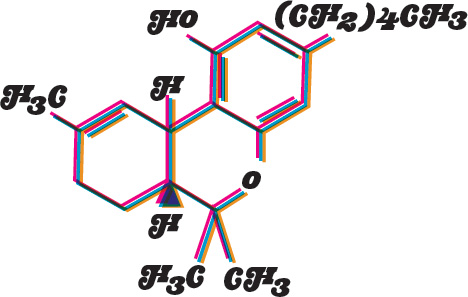
WHY DO YOU GET HIGH?

Every stoner will tell you there’s nothing like the feeling of being high. But most stoners can’t tell you exactly how smoking or eating or vaporizing the buds of the cannabis plant get you high.
Whether or not someone is aware of all the chemical reactions that take you from plain reality to blissfully wacky, it still works. But it’s worth it to take a minute to understand the basic science of marijuana.
Marijuana is the preparation of the Cannabis sativa plant intended for use as a psychoactive drug for recreational and medicinal purposes. The active ingredient in marijuana is the naturally occurring chemical “tetrahydrocannabinol,” commonly known as THC.
THC is considered a “cannabinoid,” which is part of a class of compounds that activate cannabinoid receptors in the human body to create changes in the brain and other organs. Cannabinoids are produced naturally in the body, synthetically by scientists, and most commonly, naturally in nature in the form of THC in cannabis.
THC causes moderate pain-relieving effects; produces feelings of relaxation via the central nervous system; stimulates the appetite; reduces aggression; and alters the senses of sight, sound, and smell. And despite the fact that this chemical compound can cause such big changes to the body, there has never been a documented fatality from consumption of marijuana via THC in its natural form. On the other hand, there have been several deaths attributed to the synthetic cannabinoid Marinol, produced by pharmaceutical companies for profit, when free cannabis would do a better job for free. Go figure.
Now, this is the part of the page where the technical scientific description of “getting high” should go. But really, using all the proper scientific terms—like “secondary metabolites” and “partial agonistic activity” and “inhibition of adenylate cyclase”—would just confuse us and confuse you and cause a major buzzkill to anyone who got this far on this page.
So, to put it simply, when you smoke or vaporize cannabis in a joint or bowl or bong or vaporizer, within a couple seconds the THC goes into your lungs then into your heart then into your bloodstream then into your brain where the THC activates the chemical cannabinoid receptors and causes feelings of euphoria, giddiness, loss of inhibition, increased relaxation, decreased stress and anxiety, enhanced appetite, and more good stuff.
And when you eat cannabis—after cooking it—it takes a bit longer for the THC to get to your brain since it first has to pass through the digestive system. Some weed-eaters feel the effects within about twenty minutes; others start feeling the effects after up to an hour. Many say the buzz from eating weed is different than smoking it, causing a more full-body sensation and more psychoactive experiences.
At the end of the day, this is all what the scientists say, and we appreciate that. But if you ask us how marijuana works . . . it’s magic.